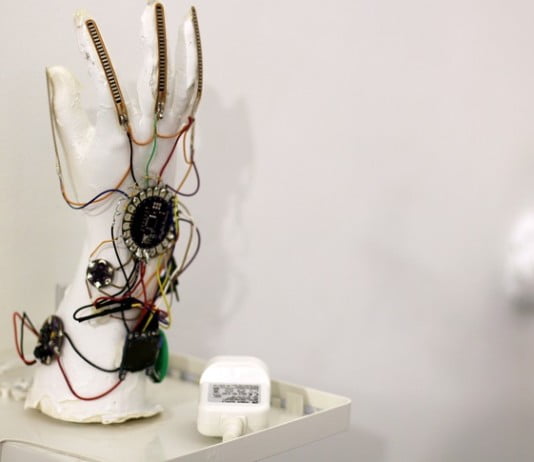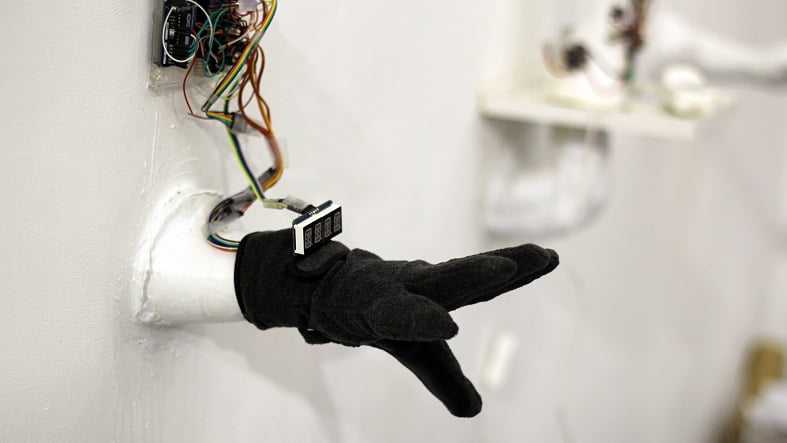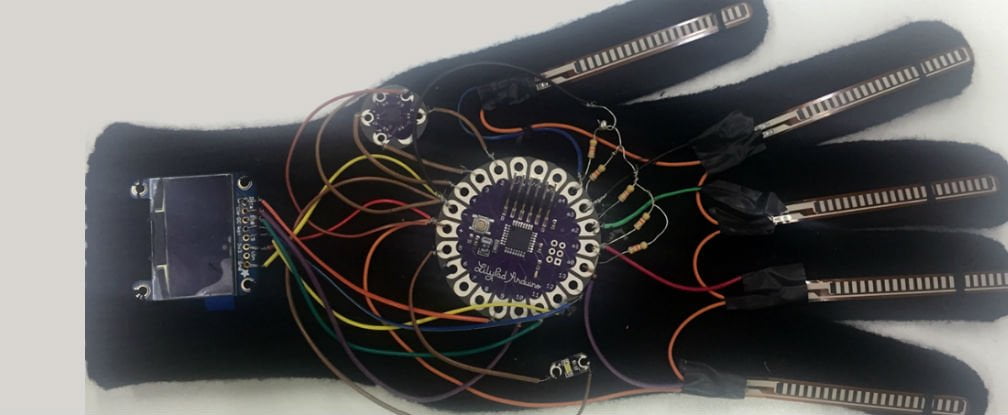Sign language has helped the hearing impaired to communicate and show their feelings, but this long-standing language of gestures has now been given a 21st-century technological upgrade.A Student Hadeel Ayoub has invented a smart glove which translates sign language into text and speech. The smart glove recognises hand movements and translates sign language into the relevant text.
Inventor Hadeel Ayoub is a designer and media artist, who has just completed her MA in Computational Arts from the Department of Computing, from Goldsmiths, University of London created the wireless Sign Language Glove to improve communication between people with different disabilities. Earlier this year she won an Innovation and Entrepreneurship Prize for Saudi Students in the UK for an early glove prototype.
Also See : [p2p type=”slug” value=”philips-launched-web-enabled-lighting-philips-hue” attributes=”target=’_blank'”]Philips Launched Web-Enabled Lighting,Philips Hue In India[/p2p]
How Does It Work?
Her first experimental prototype translated sign language gestures into visual letters on a screen. The glove’s circuit comprised of flex sensors, an accelerometer, a microcontroller board, and a four digit graphic numerical display.
Five flex sensors were attached to the glove corresponding to the five fingers, detecting bends and curvatures then reporting the values to a serial monitor. An accelerometer was attached to detect the orientation of the hand.
Hadeel also developed a computer programme that identifies the output values of the sensors and accelerometer and matches them with a series of statements which determine what letters to display on a screen.
Also See : [p2p type=”slug” value=”samsung-announced-first-6gb-ram-chips” attributes=”target=’_blank'”]Samsung Going To Power Next Generation Smartphones With 6GB RAM Chips[/p2p]
Her second prototype was better, faster and more durable, with smaller hardware and more efficient software. She incorporated a smaller microcontroller and smaller flex sensors and redesigned the software to allow text to scroll on a screen, deleting the old and adding the new.
The third and latest prototype – which now incorporates a text-to-speech chip – went on display at the Goldsmiths MA/MFA Computational Arts end-of-degree show earlier this month. Much of the glove’s hardware is now sewn into a lining:
“I didn’t want all the wires to intimidate users, making them feel the glove will be complicated to use or really fragile,” — Hadeel explains. “People tend to lean to the cautious side when approached with new high-tech products which contradicts the main purpose of this glove, which is to help make lives easier.”
Hadeel is already working on a fourth version that includes a smart phone and tablet app which can receive the glove’s output over WiFi.
As an Arabic, French and English speaker, she also intends to introduce a translation feature into the app, enabling text translation in real-time. Hadeel plans to improve the glove’s accuracy with the introduction of a motion sensor for better mapping, and also wants to develop a smaller version of the glove to fit children – a new challenge to minimise the hardware.
Also See : [p2p type=”slug” value=”qualcomm-snapdragon-flight-the-technology-to-develop-advance-drones” attributes=”target=’_blank'”]Qualcomm Snapdragon Flight – The Technology To Develop Advance Consumer Drones Ever[/p2p]
She’s been approached by several companies interested in taking the glove into production. The fourth prototype is expected to cost around £255 to produce but Hadeel hopes that if the glove is made available on the mass market, users with disabilities will not have to pay for it. Instead, schools and companies will purchase them for their employees, students and patients.
Hadeel says: “I had one mission when I started this project and it was to facilitate communication between all kinds of disabilities, eliminating barriers between people who have a visual, hearing or speech impairment. The prototypes each have a new additional feature, an LED light, and a speaker for example, that took me one step closer to my goal.
“Once I’ve incorporated WiFi and translation features into it the glove will be useful for all – no exclusions as to who the user can reach, wherever, whoever, from any country at any time.”
Just like Google Translate can give anyone a basic grasp of a foreign language in an instant, this smart glove is designed to help sign language users make themselves understood by those who can’t usually interpret it.
Also See : [p2p type=”slug” value=”bluetooth-alternative-developed-a-new-technology-transfer-data-through-body” attributes=”target=’_blank'”]Forget Bluetooth,Researchers Developed A New Technology That Transmit Data Through Your Body[/p2p]




